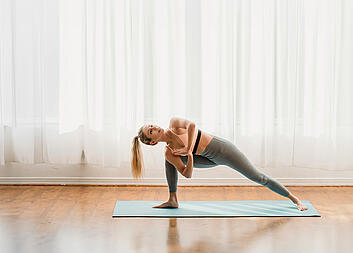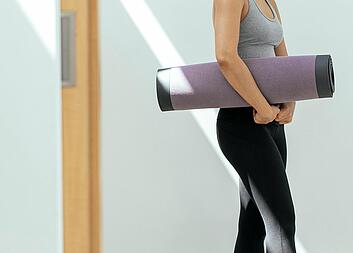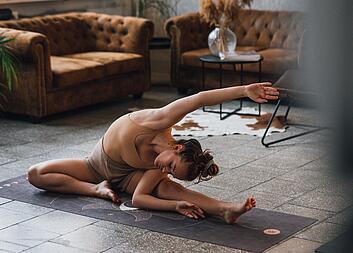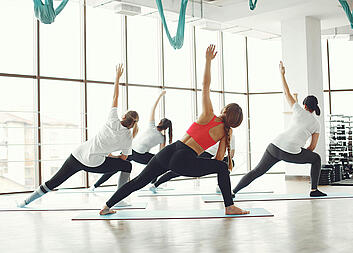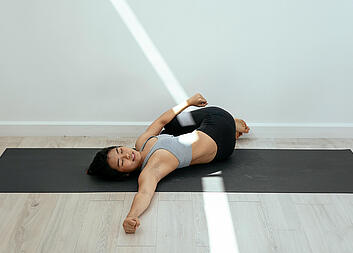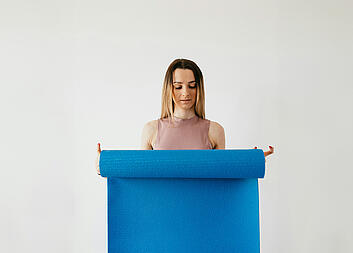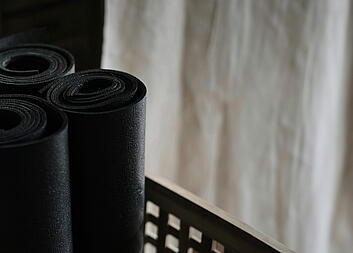We have collected the most important questions about Pilates for you and answer them in our FAQ.
Pilates- FAQ
We answer the most frequently asked questions about Pilates


Answers to the most frequently asked questions about Pilates
Pilates is a movement method that focuses on building strength from your center. That means the deep muscles in your abdomen, lower back, and pelvic floor. These muscles help support your spine, improve your posture, and give you balance and stability in everyday life.
The exercises are done slowly and with control. You don't push through repetitions or aim for exhaustion. Instead, you focus on the quality of each movement. You breathe in a specific way, coordinate it with your body, and train your awareness along with your strength. That's what makes Pilates different from many other forms of training.
Most Pilates is done on a mat using your own body weight. Sometimes small props are added, like a soft ball or a foam roller. There's also Pilates on machines, especially the Reformer, which uses springs and straps to add resistance or support. The principle stays the same: move from your center, move with purpose, move with precision.
Pilates works for beginners and experienced movers alike. It's used in physical therapy, in sports training, and by people who just want to feel better in their own body. Over time, your posture improves, your movements become clearer, and you begin to carry yourself differently. That's not because you're doing more. It's because you're doing it better.
Pilates is the name of the man who developed the method. Joseph Pilates created it in the early 20th century. He originally called it Contrology because it was about learning to control the body through movement, breath, and focus. The name Pilates became more common later, and now it refers to both the method and the mindset behind it.
In practice, Pilates means training with purpose. You don't just go through the motions. You move with attention and aim to improve how your body functions, not just how it looks. That includes balance, coordination, breathing, and posture.
Pilates also means taking your time. It's not about pushing through. It's about slowing down enough to notice how you're moving and what's working or not. That can be unfamiliar at first, but it's a skill that builds over time.
So when someone says they do Pilates, they're talking about more than a workout. They're talking about a method that connects movement with awareness. It doesn't promise quick fixes. What it offers is structure, clarity, and a stronger relationship with your body.
Pilates training is a structured way to improve strength, posture, and body awareness. The focus is on the deep muscles of your core. That includes your abdominal muscles, lower back, and pelvic floor. These muscles are often underused but play a key role in keeping your body stable and balanced.
In a Pilates session, you move with control and precision. You concentrate on alignment, breathing, and coordination. The exercises may look simple, but they can be surprisingly demanding, especially when done correctly. It's not about how many reps you can do. It's about how well you do them.
You can train on a mat or with machines like the Reformer. The Reformer uses springs and pulleys to add resistance or support. Both forms are based on the same core principles: move from the center, work with breath, and pay close attention to how your body feels and moves.
Pilates training can be adapted to all levels. Whether you're coming back from an injury or looking to refine your athletic performance, the method meets you where you are. It's not about perfection. It's about learning to move in a way that supports your body over time.
A Pilates class is a guided training session where you learn to move with control, stability, and purpose. Classes can be in person or online, in groups or one-on-one. Most classes follow a clear structure. You warm up, go through a series of targeted exercises, and often end with focused breathing or alignment work.
Many classes are done on the mat using bodyweight. Some use props like bands, balls, or rollers. There are also classes with equipment, especially the Reformer, which adds resistance through springs and can support or challenge you depending on the setup.
In a well-taught class, the instructor guides you through movements while giving you space to focus inward. It's not about doing every exercise perfectly right away. It's about developing the ability to feel what your body is doing and make adjustments in real time.
Pilates classes vary in pace and intensity. Some are gentle and therapeutic, others more dynamic and athletic. But the underlying principle stays the same: move with awareness, strengthen your center, and create a better foundation for your body to function well.
Joseph Hubertus Pilates was born in Germany in 1883. As a child, he faced serious health challenges, including asthma and rheumatic fever. These early experiences led him to explore movement, anatomy, and physical culture. He studied gymnastics, boxing, martial arts, and yoga. Over time, he developed his own method for building strength, control, and resilience through movement.
During World War I, he was interned in England as a German national. While there, he began developing exercises to help fellow detainees maintain their physical health. After the war, he moved to the United States and opened a studio in New York, where his method gained popularity, especially among dancers and performers.
Joseph Pilates believed in training both the body and the mind. His approach was methodical and rooted in observation. He designed exercises and equipment to support alignment, control, and functional strength. He called his method Contrology.
He continued to teach and refine his system until his death in 1967. Today, his legacy lives on in studios, clinics, and homes around the world. The method that bears his name is still based on the same core idea: use your body well, and it will serve you better.
Pilates was created by Joseph Pilates, a German-born movement teacher and physical trainer. His goal was to build a system that trains the whole body through precise, intentional movement. He developed his method over decades, drawing from personal experience, observation, and various movement traditions.
Joseph didn't invent Pilates overnight. It evolved as he worked with people of all kinds-dancers, athletes, soldiers, and patients recovering from injuries. He designed mat-based exercises and built equipment that helped people move better, not just harder. His approach focused on posture, breathing, and core strength.
What made his work different was the emphasis on quality over quantity. Joseph believed that a few well-performed movements were more effective than many poorly done ones. That idea is still central to Pilates today.
Although the method has been adapted over time, the foundation remains his. Whether you're on a mat or using a Reformer, the principles of Joseph Pilates are at the core: move with control, build strength from within, and treat the body as a connected system.
Pilates strengthens your core, improves your posture, and helps you move more efficiently. It targets the muscles that support your spine and pelvis, so you feel more stable in everyday activities. Whether you're sitting, walking, or lifting something, your body works better when your center is strong.
It also helps you notice how you move. You become more aware of your habits-how you stand, how you breathe, how you react to tension. That awareness gives you more control and makes it easier to avoid strain or injury.
Many people find that Pilates reduces back pain, loosens tight shoulders, and improves flexibility over time. It's not about dramatic changes. It's about building strength that lasts and movement patterns that support your daily life.
Pilates won't give you instant results. But if you stay consistent, it will change how you carry yourself. You'll stand taller, move with more intention, and feel more connected to your body.
Pilates improves how you move, how you breathe, and how your body supports itself. It strengthens deep muscles that are often overlooked in other types of training. These muscles hold your spine in place, stabilize your pelvis, and keep your body balanced in motion.
It also improves your posture. If you spend a lot of time sitting or standing in poor alignment, your body adapts in ways that create tension. Pilates helps undo those patterns. You learn to align yourself better and move in a way that puts less strain on your joints and muscles.
Your coordination and focus improve too. Since you have to move with control, your mind stays active throughout the practice. That mental engagement supports long-term learning and body awareness.
Over time, Pilates can reduce chronic pain, especially in the lower back, neck, and shoulders. It won't fix everything, but it gives your body tools to support itself more effectively. And that can make a big difference.
Pilates trains you to move with purpose. It doesn't just make you stronger-it helps you understand how strength works in your own body. You build it from the inside out, starting with your core and working outward in a way that supports balance and posture.
It teaches you to move better, not just more. That means you can walk, sit, lift, or bend without unnecessary tension. You use the right muscles for the right job. That reduces stress on your joints and helps prevent injury.
It also helps with breathing. You learn to coordinate your breath with movement, which can improve focus and reduce physical strain. That's useful not only in exercise but in daily life, especially in stressful situations.
What Pilates does most of all is make you more aware. You begin to notice how you stand, how you hold yourself, and how you respond to effort. That awareness is the real foundation. Once you have it, everything else in your movement can shift.
There are two main types of Pilates: mat-based and equipment-based. Mat Pilates uses your body weight and sometimes small props like balls or bands. It focuses on control, alignment, and strength without relying on machines.
Equipment Pilates is done on machines like the Reformer, Cadillac, or Chair. These devices use springs to create resistance or support, allowing for a wide range of exercises. They can make movements easier or more challenging, depending on how they're set up.
Beyond that, there are different styles or schools. Some follow Joseph Pilates' original method closely. Others adapt the exercises with a therapeutic or athletic focus. Some combine Pilates with yoga, barre, or functional training.
The best type for you depends on your body, your goals, and your preferences. Mat work gives you independence-you can do it anywhere. Equipment work gives you precision and feedback. Both share the same foundation: control, breath, focus, and a strong center.
Pilates is a movement method that focuses on building strength from your center. That means the deep muscles in your abdomen, lower back, and pelvic floor. These muscles help support your spine, improve your posture, and give you balance and stability in everyday life.
The exercises are done slowly and with control. You don't push through repetitions or aim for exhaustion. Instead, you focus on the quality of each movement. You breathe in a specific way, coordinate it with your body, and train your awareness along with your strength. That's what makes Pilates different from many other forms of training.
Most Pilates is done on a mat using your own body weight. Sometimes small props are added, like a soft ball or a foam roller. There's also Pilates on machines, especially the Reformer, which uses springs and straps to add resistance or support. The principle stays the same: move from your center, move with purpose, move with precision.
Pilates works for beginners and experienced movers alike. It's used in physical therapy, in sports training, and by people who just want to feel better in their own body. Over time, your posture improves, your movements become clearer, and you begin to carry yourself differently. That's not because you're doing more. It's because you're doing it better.
What does Pilates mean? //
Pilates is the name of the man who developed the method. Joseph Pilates created it in the early 20th century. He originally called it Contrology because it was about learning to control the body through movement, breath, and focus. The name Pilates became more common later, and now it refers to both the method and the mindset behind it.
In practice, Pilates means training with purpose. You don't just go through the motions. You move with attention and aim to improve how your body functions, not just how it looks. That includes balance, coordination, breathing, and posture.
Pilates also means taking your time. It's not about pushing through. It's about slowing down enough to notice how you're moving and what's working or not. That can be unfamiliar at first, but it's a skill that builds over time.
So when someone says they do Pilates, they're talking about more than a workout. They're talking about a method that connects movement with awareness. It doesn't promise quick fixes. What it offers is structure, clarity, and a stronger relationship with your body.
What is Pilates training? //
Pilates training is a structured way to improve strength, posture, and body awareness. The focus is on the deep muscles of your core. That includes your abdominal muscles, lower back, and pelvic floor. These muscles are often underused but play a key role in keeping your body stable and balanced.
In a Pilates session, you move with control and precision. You concentrate on alignment, breathing, and coordination. The exercises may look simple, but they can be surprisingly demanding, especially when done correctly. It's not about how many reps you can do. It's about how well you do them.
You can train on a mat or with machines like the Reformer. The Reformer uses springs and pulleys to add resistance or support. Both forms are based on the same core principles: move from the center, work with breath, and pay close attention to how your body feels and moves.
Pilates training can be adapted to all levels. Whether you're coming back from an injury or looking to refine your athletic performance, the method meets you where you are. It's not about perfection. It's about learning to move in a way that supports your body over time.
What is a Pilates class? //
A Pilates class is a guided training session where you learn to move with control, stability, and purpose. Classes can be in person or online, in groups or one-on-one. Most classes follow a clear structure. You warm up, go through a series of targeted exercises, and often end with focused breathing or alignment work.
Many classes are done on the mat using bodyweight. Some use props like bands, balls, or rollers. There are also classes with equipment, especially the Reformer, which adds resistance through springs and can support or challenge you depending on the setup.
In a well-taught class, the instructor guides you through movements while giving you space to focus inward. It's not about doing every exercise perfectly right away. It's about developing the ability to feel what your body is doing and make adjustments in real time.
Pilates classes vary in pace and intensity. Some are gentle and therapeutic, others more dynamic and athletic. But the underlying principle stays the same: move with awareness, strengthen your center, and create a better foundation for your body to function well.
Who was Pilates? //
Joseph Hubertus Pilates was born in Germany in 1883. As a child, he faced serious health challenges, including asthma and rheumatic fever. These early experiences led him to explore movement, anatomy, and physical culture. He studied gymnastics, boxing, martial arts, and yoga. Over time, he developed his own method for building strength, control, and resilience through movement.
During World War I, he was interned in England as a German national. While there, he began developing exercises to help fellow detainees maintain their physical health. After the war, he moved to the United States and opened a studio in New York, where his method gained popularity, especially among dancers and performers.
Joseph Pilates believed in training both the body and the mind. His approach was methodical and rooted in observation. He designed exercises and equipment to support alignment, control, and functional strength. He called his method Contrology.
He continued to teach and refine his system until his death in 1967. Today, his legacy lives on in studios, clinics, and homes around the world. The method that bears his name is still based on the same core idea: use your body well, and it will serve you better.
Who invented Pilates? //
Pilates was created by Joseph Pilates, a German-born movement teacher and physical trainer. His goal was to build a system that trains the whole body through precise, intentional movement. He developed his method over decades, drawing from personal experience, observation, and various movement traditions.
Joseph didn't invent Pilates overnight. It evolved as he worked with people of all kinds-dancers, athletes, soldiers, and patients recovering from injuries. He designed mat-based exercises and built equipment that helped people move better, not just harder. His approach focused on posture, breathing, and core strength.
What made his work different was the emphasis on quality over quantity. Joseph believed that a few well-performed movements were more effective than many poorly done ones. That idea is still central to Pilates today.
Although the method has been adapted over time, the foundation remains his. Whether you're on a mat or using a Reformer, the principles of Joseph Pilates are at the core: move with control, build strength from within, and treat the body as a connected system.
What does Pilates do for you? //
Pilates strengthens your core, improves your posture, and helps you move more efficiently. It targets the muscles that support your spine and pelvis, so you feel more stable in everyday activities. Whether you're sitting, walking, or lifting something, your body works better when your center is strong.
It also helps you notice how you move. You become more aware of your habits-how you stand, how you breathe, how you react to tension. That awareness gives you more control and makes it easier to avoid strain or injury.
Many people find that Pilates reduces back pain, loosens tight shoulders, and improves flexibility over time. It's not about dramatic changes. It's about building strength that lasts and movement patterns that support your daily life.
Pilates won't give you instant results. But if you stay consistent, it will change how you carry yourself. You'll stand taller, move with more intention, and feel more connected to your body.
What does Pilates improve? //
Pilates improves how you move, how you breathe, and how your body supports itself. It strengthens deep muscles that are often overlooked in other types of training. These muscles hold your spine in place, stabilize your pelvis, and keep your body balanced in motion.
It also improves your posture. If you spend a lot of time sitting or standing in poor alignment, your body adapts in ways that create tension. Pilates helps undo those patterns. You learn to align yourself better and move in a way that puts less strain on your joints and muscles.
Your coordination and focus improve too. Since you have to move with control, your mind stays active throughout the practice. That mental engagement supports long-term learning and body awareness.
Over time, Pilates can reduce chronic pain, especially in the lower back, neck, and shoulders. It won't fix everything, but it gives your body tools to support itself more effectively. And that can make a big difference.
What does Pilates actually do? //
Pilates trains you to move with purpose. It doesn't just make you stronger-it helps you understand how strength works in your own body. You build it from the inside out, starting with your core and working outward in a way that supports balance and posture.
It teaches you to move better, not just more. That means you can walk, sit, lift, or bend without unnecessary tension. You use the right muscles for the right job. That reduces stress on your joints and helps prevent injury.
It also helps with breathing. You learn to coordinate your breath with movement, which can improve focus and reduce physical strain. That's useful not only in exercise but in daily life, especially in stressful situations.
What Pilates does most of all is make you more aware. You begin to notice how you stand, how you hold yourself, and how you respond to effort. That awareness is the real foundation. Once you have it, everything else in your movement can shift.
What types of Pilates are there? //
There are two main types of Pilates: mat-based and equipment-based. Mat Pilates uses your body weight and sometimes small props like balls or bands. It focuses on control, alignment, and strength without relying on machines.
Equipment Pilates is done on machines like the Reformer, Cadillac, or Chair. These devices use springs to create resistance or support, allowing for a wide range of exercises. They can make movements easier or more challenging, depending on how they're set up.
Beyond that, there are different styles or schools. Some follow Joseph Pilates' original method closely. Others adapt the exercises with a therapeutic or athletic focus. Some combine Pilates with yoga, barre, or functional training.
The best type for you depends on your body, your goals, and your preferences. Mat work gives you independence-you can do it anywhere. Equipment work gives you precision and feedback. Both share the same foundation: control, breath, focus, and a strong center.
More on Pilates
